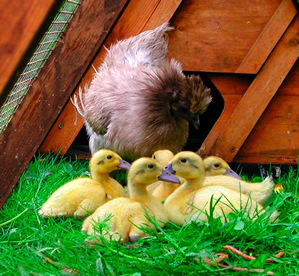|
Using
broody hens to hatch ducklings
Ð
some pros and cons
First
published in the IRDA Newsletter Spring 2003
As spring
approaches, thoughts turn to hatching out ducklings. But how
to go about it? I use both an incubator and broody hens. On
the whole I get more reliable results from the broodies, usually
100% without the early death or dead in shell I sometimes
get with the incubator (from which I never get the same result
twice). I've found setting two batches, one artificially and
one under a hen has been a help in calibrating the temperature
of my very basic still-air incubator, and identifying problems
with humidity which I might otherwise have attributed to disease.
However,
setting duck eggs under hens is not without it's problems.
Although many hens will 'go broody ', relatively few will
do so reliably. The first time one of my marans went broody
I was overjoyed. I'd read that heavy breeds had a reputation
for being good broodies, so I put some fertile eggs under
her. She incubated them very well, but as soon as they hatched
she became visibly disturbed at the cheeping, and started
attacking the chicks. I whipped them out very quickly and
reared them under a lamp. I've found this to be the case with
most large fowl; they will sit well on a clutch of eggs but
have absolutely no idea what to do once they start hatching,
and will sometimes attack the chicks as soon as they start
to pip. They are particularly vulnerable just after they first
break through the shell, when the hen can peck off the end
of the emerging beak.
Bantams
and Silkies make much better mothers, but also have their
disadvantages. As duck eggs are much larger than bantam eggs,
you can only set a very few under a small hen (don't be tempted
to put too many under, as extra eggs will be cast aside and
will chill, resulting in all the eggs developing at low or
irregular temperatures). Check every couple of hours after
setting the eggs, and remove any that have been cast aside.

|
| |
|
|

Silkies are
excellent incubation machines, but again have their problems. I
can fit upto 6 under my smallish ones, but although they are the
gentlest of creatures I always remove the eggs at the pipping stage
and place them in an incubator (and carry on under artificial heat).
I did once leave them only to lose the whole hatch. I found the
newly hatched chicks dead, with silkie fluff stuck to their bills.
When ducklings hatch, they are rather damp, especially their bills
which have a rather larger surface area in comparison with those
of chicks for feathers to stick to. The down had adhered to the
wet bills as readily as if they'd been covered with glue and they
had suffocated.
To sum up:
- use a hen that you know to be reliable, don't just assume
they will all do what 'comes naturally'. If possible use a cross
with a breed known for it's good mothering qualities, but large
enough to incubate a reasonable brood.
- Keep a close
eye on the eggs around the time you expect them to start pipping,
especially with an untried hen. Have an incubator/brooder ready,
even if you want to try them with the hen. If there are any problems
you won't have to panic finding something to do with any rejected
hatchlings.
- Observe
the usual rules that apply to hens, such as de-lousing the broody
before hand and using a coop free from red-mite. Also make sure
she is in good general health, as brooding is quite taxing; micro-organisms
can easily multiply in the bird's sluggish alimentary system resulting
in digestive disorders and sour-crop (and consequently some very
dirty/contaminated hatching eggs).
|

